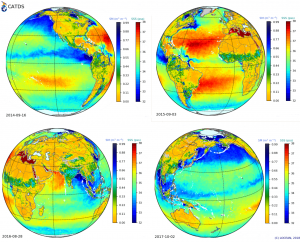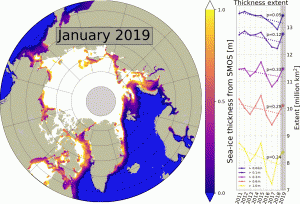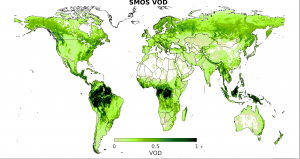Yes indeed!
10 years ago, early in the day with a completely overcast sky, SMOS soared into the skies.
And after that, dutifully and without almost no interruption, the mission has delivered an outstanding data stream … So congratulations to the project team who did this wonderful mission, and thanks to the operation teams who do the utmost to deliver the data in a timely and quality driven fashion…
So where are we after ten years? …
On top of all that was planned in terms of soil moisture and Sea surface salinity…
Figure 1 from Dimitry Khvorostyanov (LOCEAN)
SMOS is used operationally at ECMWF in the IFS since June 2019
SMOS is used operationally to infer sea ice thickness, freeze thaw and also measures the internal temperature of the Antarctica Ice sheet…
Figure 2 Sea Ice extent dévolution since SMOS Launch (Lars Kaleschke AWI)
SMOS is able to quantify high levels of biomass (300 t/ha) using the L-VOD this is also un precedented. It proved it ability to detect droughts in advance and help forecasting floods.
Figure 3 SMOS VOD (Arnaud Mialon)
SMOS is used to improve rainfall estimates from satellite over both land and oceans, is unique for monitoring High winds (hurricanes and tornadoes)
Etc etc … I stop here as the list is too long and will get soon boring. All I may add is that very novel uses are still coming out or on the verge of popping out (liquid water in snow and ice, green house gas emissions, …) so stay tuned.
Last but not least, we now have 10 years of continuous data at reach. We can start to study tele-connections, climate trends indicators or hints of them etc. The treasure box is far from being exhausted, believe me.
I may be biased but I do not think any mission can claim more results in so little time than SMOS -especially for an explorer missions. Did you realise we have already over 1400 publications (h index of 68) in WoS? including 3 (and several more coming) in Nature journals and 20 highly cited papers?
So to make a long story short,
long life to SMOS !
Many thanks to all those who work every day with much dedication to provide us with the good data.
If as a user you have new results let us know! We like to keep abreast of all what is going on! This blog could be your sounding board
And let’s hope our decision makers will soon come to their sense and enable a SMOS/L- band radiometer follow mission to emerge – if only to satisfy the operational users!



